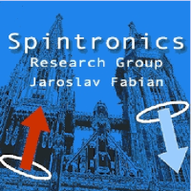
Spintronics
We are a theoretical Condensed Matter group at the University of Regensburg with a research focus on Spin(Elec)tronics phenomena in complex systems at the nanoscale.
Our current research activities comprise first-principles studies of twisted heterostructures based on van der Waals materials and 2D magnets (twistronics), together with spin and magnetic-exchange proximity effects, as well as spin-orbit torques and magnetization dynamics. Moreover, we explore charge and spin transport properties of superconducting magnetic tunnel junctions (superconducting spintronics) controlled by spin-orbit interactions or inhomogeneous magnetization, including the recently intensively investigated supercurrent diode effect.

Our group (with Master's student Sareh Bazyar, right) in October 2024
: RECENT RESEARCH HIGHLIGHTS :
Combining Ab-initio and Machine Learning to Predict Proximity Effects in van-der-Waals Heterostructures
Proximity effects occur at the interface of van-der-Waals heterostructures and are highly sensitive to the local stacking geometry at the atomic scale. Each atom experiences a unique environment, leading to significant variation in interactions – even between neighboring atoms. These effects are inherently complex and have so far resisted accurate description by analytical models.
To capture this complexity, we developed a machine-learning framework that links atomic-scale structure to proximity-induced properties. Trained on high-fidelity data, the model learns how subtle variations in stacking and local atomic configuration influence the physical response. This enables us to probe interface physics beyond the reach of conventional theory and reveals intricate spatial patterns of proximity effects across the material.
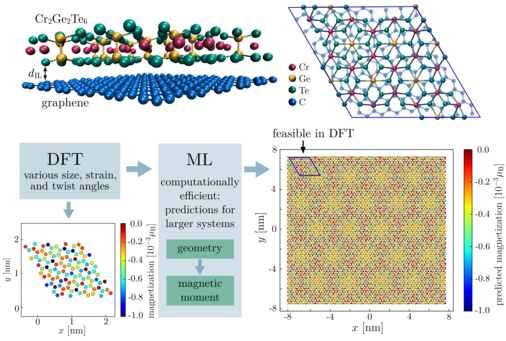
This work has been published in the preprint arXiv:2508.12406.
Technical Review in Nature Reviews Physics: First-principles determination of spin-orbit coupling parameters in two-dimensional materials
Spin-orbit coupling (SOC) is fundamental to many phenomena in solid-state physics. Two-dimensional materials and van der Waals heterostructures provide researchers with exquisite control over this interaction; the ability to fine-tune SOC has impacts on spin transport and relaxation, topological states, optoelectronics, magnetization dynamics, and even superconductivity and other correlated states.
Our Technical Review covers both the theoretical methodology and experimentally relevant phenomenology of SOC in 2D materials by providing essential insights into the process of extracting the spin interactions from the underlying electronic structure obtained from first-principles density functional theory calculations.
We start our review with graphene. Its SOC has a surprisingly complicated origin yet graphene remains the benchmark for other elemental centrosymmetric 2D materials in which SOC leads to a mixing of spin-up and spin-down components of the Bloch states. We then discuss spin-orbit materials, such as transition-metal dichalcogenides, in which strong SOC and the lack of space-inversion symmetry yield large spin splittings of the valence and conduction bands. This enables highly efficient optical spin orientation or a robust valley Hall effect in transition-metal dichalcogenides. Next, we give guidelines for extracting the spin–orbit characteristics of van der Waals heterostructures, such as graphene/WSe2, which serve as a platform for SOC engineering. For these representative systems, we highlight the essentials of first-principles-based methodology, including supercell formation, strain artifacts, twisting, gating, and lattice relaxation. Finally, we briefly discuss the effects of proximity exchange coupling, which is another relevant spin interaction for spintronics.

This review article has been published in Nature Reviews Physics.
Unconventional Josephson Supercurrent Diode Effect Induced by Chiral Spin-Orbit Coupling
The lacking mirror symmetry in chiral materials – e.g., in twisted van-der-Waals homobilayers – can rise unconventional spin-orbit fields such as fully momentum-aligned radial Rashba fields.
After predicting this novel radial Rashba spin-orbit coupling from first-principles calculations and performing large-scale magnetotransport calculations for proximitized graphene (see below), we studied the Cooper-pair transfer in vertical superconductor/ferromagnet/superconductor Josephson junctions that host "crossed" (tangential and radial) Rashba fields at their interfaces. We unraveled that their interplay results in what we call the unconventional supercurrent diode effect (SDE) with maximal supercurrent rectification when the magnetization of the ferromagnetic link is collinear with the supercurrent (instead of perpendicular as in the conventional SDE). We showed that the microscopic origin of the unconventional SDE – spin precessions inside the ferromagnet – is well distinct from the Rashba-induced effects on Cooper-pair momenta in the conventional SDE, making it a particularly sensitive probe of interfacial chiral spin textures.

This work has been published in the Letter section of Physical Review B.
Magnetotransport and Spin-Relaxation Signatures of the Radial Rashba and Dresselhaus Spin-Orbit Coupling in Proximitized Graphene
Graphene-based van-der-Waals heterostructures offer unprecedented possibilities to engineer the proximity-induced spin-orbit fields through knobs like stacking, twisting, or gating, and might therefore provide an ideal platform to induce new unconventional types of spin-orbit coupling such as the chiral radial Rashba fields recently proposed by first-principles calculations performed in our group (see below).
In this work, we performed large-scale magnetotransport calculations based on the KWANT package to investigate transverse magnetic focusing and Dyakonov–Perel spin relaxation in proximitized graphene. Our results guide to practical experimental signatures to disentangle radial from conventional (tangential) Rashba and/or Dresselhaus spin-orbit coupling. Moreover, we demonstrated that a radial Rashba component in a two-dimensional electron gas will impose a characteristic magnetization-angle shift on the superconducting-diode-effect efficiency, allowing us to determine the so-called Rashba angle and thereby quantify the amount of radial Rashba coupling in these "crossed" spin-orbit fields.

This work has been published in Physical Review Letters.
Swapping Exchange and Spin-Orbit Induced Correlated Phases in Proximitized Bernal Bilayer Graphene
Combining sophisticated simulations and theoretical models, we discovered that we can electrically control the electronic behavior of Bernal bilayer graphene sandwiched between magnetic Cr2Ge2Te6 and strong spin-orbit-coupling-inducing WS2 layers to explore a wide range of correlated phases within a single system. Our research opens up novel possibilities to design such advanced EX-SO-tic van-der-Waals devices with tunable properties, simultaneously exploiting magnetic exchange (EX) and spin-orbit coupling (SO).

This work has been published in Physical Review B .
Emergence of Radial Rashba Spin-Orbit Fields in Twisted Van-Der-Waals Heterostructures
From first-principles calculations, we investigated the functional form of the spin-orbit fields that emerge in twisted van-der-Waals heterostructures consisting of graphene and WSe2 multilayers. We proposed that the Rashba spin-orbit fields of these structures can be electrically tuned from the conventional – tangential to momentum – to a predominantly radial – parallel to momentum – spin texture. Such spin-orbit engineering could be useful to design spin-charge-conversion and spin-orbit-torque schemes, as well as for controlling correlated phases and superconductivity in van-der-Waals materials.

This work has been published in Physical Review B as Editors' Suggestion.
Link between Supercurrent Diode and Anomalous Josephson Effect Revealed by Gate-Controlled Interferometry
In collaboration with our experimental colleagues in Regensburg, we further investigated the supercurrent diode effect in two-dimensional electron gas (2DEG) Josephson junctions. We simultaneously explored the φ0-shift (anomalous Josephson effect) and the supercurrent diode effect in the same system using a superconducting quantum interferometer. Electrostatic gating of the junction revealed a direct connection between the φ0-shift and the diode effect. Our findings suggest that spin-orbit interaction plays, together with a Zeeman field, a crucial role for the supercurrent diode effect to appear.

This work has been published in Nature Communications.
Emergent Correlated Phases in Rhombohedral Trilayer Graphene Induced by Proximity Spin-Orbit and Exchange Coupling
In collaboration with Dr. Denis Kochan from the Slovak Academy of Sciences in Bratislava, we studied the impact of proximity-induced spin-orbit (through proximity to a transition-metal dichalcogenide; TMDC) and exchange coupling (through proximity to CGT) on rhombohedral trilayer graphene. We identified a rich spectrum of correlated phases that originate, e.g., from valley–Zeeman coupling, and also unraveled a magnetocorrelation effect, which causes a strong sensitivity of the correlated phases to the relative magnetization orientations (parallel or antiparallel) of the proximitizing ferromagnetic (CGT) layers.

This work has been published in Physical Review Letters.
Charge Transfer and Asymmetric Coupling of MoSe2 Valleys to the Magnetic Order of CrSBr
In an international collaboration, we investigated the control of the valley and excitonic properties of van-der-Waals heterostructures composed of two-dimensional transition-metal dichalcogenides (MoSe2) and magnetic materials (CrSBr) exploiting proximity effects. We found a clear impact of the magnetic order of CrSBr on the optical properties of MoSe2, the exciton and trion energies, and a valley g-factor reflecting asymmetric magnetic proximity interaction. Our first-principles calculations furthermore indicated that MoSe2/CrSBr forms a broken-gap band alignment and supports charge transfer.
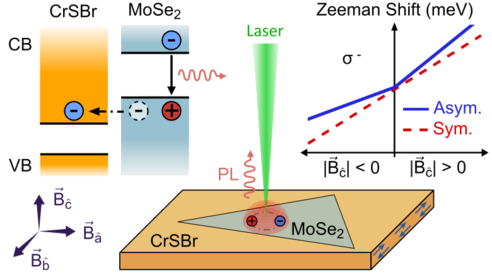
This work has been published in Nano Letters.
Electronic and Spin-Orbit Properties of hBN Encapsulated Bilayer Graphene
In collaboration with experimental colleagues from RWTH Aachen and Forschungszentrum Jülich, we employed first-principles calculations to model the electronic properties and spin-orbit coupling of bilayer graphene encapsulated by hexagonal boron-nitride (hBN). We extracted the spin-orbit coupling parameters fitting the computed band structures to a model Hamiltonian and furthermore studied the impact of twisting.
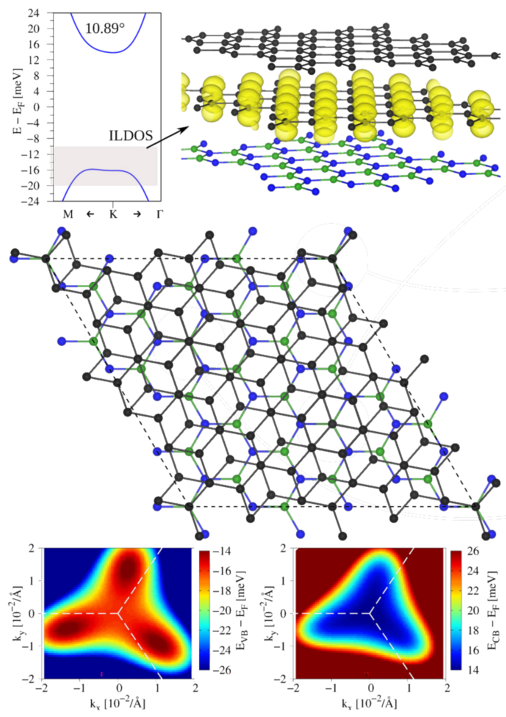
This work has been published in Physical Review B.
Sign Reversal of the Josephson Inductance Magnetochiral Anisotropy and 0–π-like Transitions in Supercurrent Diodes
After the first realization of a supercurrent diode based on two-dimensional electron gas (2DEG) Josephson junctions in the group of Prof. Dr. Christoph Strunk/Dr. Nicola Paradiso at UR, which we supported with theoretical calculations (Ref. 1, Ref. 2), we demonstrate in a recent work – again in close collaboration with our experimental colleagues – the peculiar role of 0–π-like transitions for the reversal (sign change) of both the supercurrent diode effect and the magnetochiral anisotropy. Our findings provide an important contribution to establish supercurrent diodes as the dissipationless counterparts of present-day semiconductor diodes and as essential building blocks of future electronic devices.
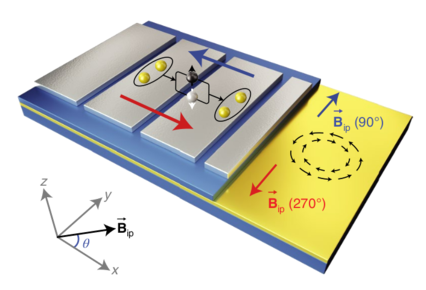
This work has been published in Nature Nanotechnology and Physical Review B.
The UR press release can be found here.
>>> More Research Highlights >>>
Fabian Group
SPINTRONICS
Secretarial Office:
+49 (0)941 943 2030 / 2434
fabian.office@ur.de
SFB 1277-Office:
+49 (0)941 943 2264
sfb1277.office@ur.de

